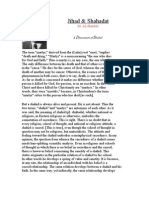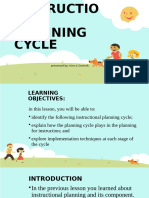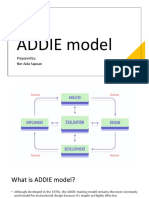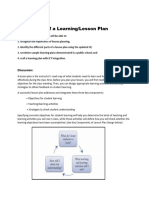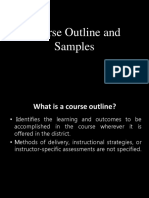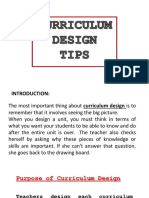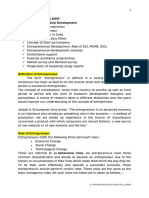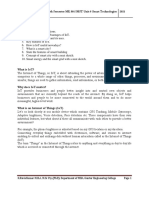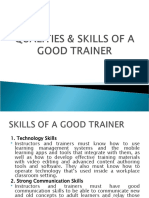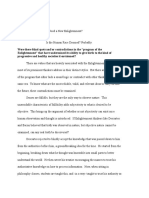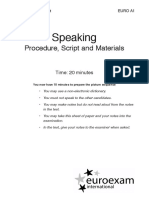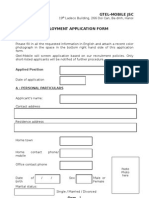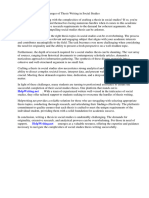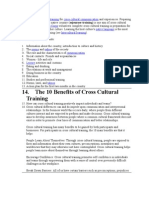0 ratings0% found this document useful (0 votes)
31 viewsUnit - 3 - Session Plan
Unit - 3 - Session Plan
Uploaded by
Kommineni Ravie KumarThe document provides guidance on developing effective instructional objectives and session plans for training. It outlines that instructional objectives should be SMART (Specific, Measurable, Attainable, Relevant, Time-framed). A session plan details the activities, resources, and evaluations that will be used to guide learners towards meeting the objectives. It recommends using a template to organize the topics, presentation methods like lectures and discussions, and evaluation steps like pre- and post-assessments. The 5E learning cycle and Kirkpatrick's model are also referenced as frameworks to structure the session.
Copyright:
© All Rights Reserved
Available Formats
Download as PPTX, PDF, TXT or read online from Scribd
Unit - 3 - Session Plan
Unit - 3 - Session Plan
Uploaded by
Kommineni Ravie Kumar0 ratings0% found this document useful (0 votes)
31 views20 pagesThe document provides guidance on developing effective instructional objectives and session plans for training. It outlines that instructional objectives should be SMART (Specific, Measurable, Attainable, Relevant, Time-framed). A session plan details the activities, resources, and evaluations that will be used to guide learners towards meeting the objectives. It recommends using a template to organize the topics, presentation methods like lectures and discussions, and evaluation steps like pre- and post-assessments. The 5E learning cycle and Kirkpatrick's model are also referenced as frameworks to structure the session.
Original Description:
mtd unit-3
Original Title
UNIT - 3 - SESSION PLAN
Copyright
© © All Rights Reserved
Available Formats
PPTX, PDF, TXT or read online from Scribd
Share this document
Did you find this document useful?
Is this content inappropriate?
The document provides guidance on developing effective instructional objectives and session plans for training. It outlines that instructional objectives should be SMART (Specific, Measurable, Attainable, Relevant, Time-framed). A session plan details the activities, resources, and evaluations that will be used to guide learners towards meeting the objectives. It recommends using a template to organize the topics, presentation methods like lectures and discussions, and evaluation steps like pre- and post-assessments. The 5E learning cycle and Kirkpatrick's model are also referenced as frameworks to structure the session.
Copyright:
© All Rights Reserved
Available Formats
Download as PPTX, PDF, TXT or read online from Scribd
Download as pptx, pdf, or txt
0 ratings0% found this document useful (0 votes)
31 views20 pagesUnit - 3 - Session Plan
Unit - 3 - Session Plan
Uploaded by
Kommineni Ravie KumarThe document provides guidance on developing effective instructional objectives and session plans for training. It outlines that instructional objectives should be SMART (Specific, Measurable, Attainable, Relevant, Time-framed). A session plan details the activities, resources, and evaluations that will be used to guide learners towards meeting the objectives. It recommends using a template to organize the topics, presentation methods like lectures and discussions, and evaluation steps like pre- and post-assessments. The 5E learning cycle and Kirkpatrick's model are also referenced as frameworks to structure the session.
Copyright:
© All Rights Reserved
Available Formats
Download as PPTX, PDF, TXT or read online from Scribd
Download as pptx, pdf, or txt
You are on page 1of 20
UNIT - 3
Instructional objectives &
Session plan
INSTRUCTIONAL OBJECTIVES
Instructional Objectives
• Before training is designed, instructional designers
first identify the instructional objectives of the
course. Instructional objectives are measurable
terms that describe what learners will be able to
do after the instruction. It is essential to have
clearly outline instructional objectives to make
sure that what is taught in the courses matches
the intended outcome.
INSTRUCTIONAL OBJECTIVES
Writing S.M.A.R.T. Objectives
• To be effective, instructional objectives should be:
• Specific. Instructional objectives should precisely
describe what is expected of a learner. For
example, the learner will be able to deal with
irritable customers, which is not a specific
objective. This could be made better by stating
how the learner will deal with the irritable
customer.
INSTRUCTIONAL OBJECTIVES
• Measurable. A measurable instructional
objective is one that can be observed or one
that generates data points. For example, the
learner will apply compassion skills to handle
irritable customers and log and report the
outcome of each call by the end of the month.
The learner’s log offers data about how the
customers reacted to the technique.
INSTRUCTIONAL OBJECTIVES
• Attainable. Learners cannot feel defeated by the
intended outcomes of the learning objectives.
Instructional objectives should not ask learners
to prove themselves under unfeasible
circumstances. Give learners ample time to prove
their new skills. For example, in the objective
above, the learner has one month to prove he or
she is effectively exercising the new skills. This is
ample time for the learner to do so.
INSTRUCTIONAL OBJECTIVES
• Relevant. Most learners do not care about
learning things that they cannot use right
away. The information presented in the course
and the outcomes should be relevant to their
personal lives or day to day work.
INSTRUCTIONAL OBJECTIVES
• Time-framed. Learners need a deadline for
when they should achieve and demonstrate
the use of the skill set. One month is the time-
frame for the objective mentioned above. A
learning objective that is not time-framed
gives learners the false impression that they
have an indefinite amount of time to learn the
skill and apply it.
SESSION PLAN
What Is a Training Session Plan?
• A training session plan – also called a learning plan – is an
organized description of the activities and resources you'll
use to guide a group toward a specific learning objective.
• It details the subject matter that you'll teach, how long each
section should take, the methods of instruction for each
topic covered, and the measures you'll use to check that
people have learned what you needed them to learn.
• It can be as simple as a brief outline, or more complex, with
scripts, prompts, and lists of questions that you plan to ask.
SESSION PLAN
Why Use a Training Session Plan?
• This helps you ensure that you've thought about everything
that you need to say, and that you present information in a
logical order. You'll also be able to prepare for points that
people might find difficult to understand.
• After your session, you can use your plan to work out what
went well – and what didn't – so that you can adapt it for
future lessons.
• Last, a training session plan will be invaluable for a substitute
instructor, if you can't make it to class.
SESSION PLAN
How to Develop a Session Plan?
• To develop a session plan, it's useful to use a
standard training plan template. This helps
you organize material consistently over
sessions, and avoid duplicating topics.
SESSION PLAN
• To create an effective training session plan,
take the following steps:
• Step 1: Define your objectives.
Step 2: Clarify key topics and related concepts.
Step 3: Organize material.
Step 4: Plan presentation techniques.
Step 5: Include evaluation.
Step 6: Focus on timing.
SESSION PLAN
Step 1: Define Learning Objectives
• Your first step is to specify what you want your trainees
to learn, and determine how you will measure this.
• Think about these questions:
• What are the most important concepts or skills that
trainees need to understand by the end of the class?
• Why are these concepts and skills important?
• How will you know that they have understood these
correctly?
SESSION PLAN
Step 2: Clarify Key Topics and Related Concepts
• Your class will focus on a few central ideas or
skills, but you'll need to explain related
concepts to reach your learning objectives.
• List your key topics and their related concepts,
and then group them together – for example,
using a diagram
SESSION PLAN
Step 3: Organize Material
• Once you have a general idea of what you need
to cover, draft a lesson outline. List all of the
points that you need to cover, in the order in
which you'll cover them.
• Use the 5 E Learning Cycle to link information
to trainees' existing skills and knowledge. This
will help them put it into a personal context,
which, in turn, will help them retain it better.
5 E Learning Cycle
SESSION PLAN
• Now think about how you will teach this
material to your students. It's best to use
several different presentation approaches to
keep students engaged, and to appeal to
people with different learning styles . (This is
very important, because learning styles vary
widely.)
SESSION PLAN
Consider using these activities in your training session:
• Lectures
• Demonstrations
• Discussions
• Role play
• Case studies
After deciding which training methods to use, have
to note them in template.
SESSION PLAN
Step 5: Include Evaluation
• Now, think about when you'll check that students have
understood key points. Build in learning checks and
question-and-answer sessions, and include these in your
template.
• Also, consider how you will evaluate the session. You may
want to use a formal measurement approach aligned
with Kirkpatrick's Four-Level Training Evaluation Model ,
or you may want to create a simple on- or off-line
questionnaire that will help you tell if the session has been
successful.
Kirkpatrick's Four-Level Training Evaluation
Model
Template of Session Plan
Session Topic: Date:
Department: Time:
Objectives:
1.
2.
3.
Content Teaching Trainee activity Resources Time
Methods
You might also like
- What Is A Training DesignDocument6 pagesWhat Is A Training DesignSai Krishna60% (5)
- Lingoda ClassDocument34 pagesLingoda ClassGareth GriffithsNo ratings yet
- Module 1 Communication Skills Multiple ChoiceDocument6 pagesModule 1 Communication Skills Multiple ChoiceMariel Corbin67% (3)
- Jihad & Shahadat - Ali ShariatiDocument12 pagesJihad & Shahadat - Ali ShariatiBMT-link100% (2)
- Training Delivery and EvaluationDocument7 pagesTraining Delivery and EvaluationRoman PanditNo ratings yet
- Effective Teaching PlanDocument24 pagesEffective Teaching PlanAbdul HadiNo ratings yet
- Unit 2 GMT GCWUFDocument22 pagesUnit 2 GMT GCWUFMadiha KhadimNo ratings yet
- Effective Lesson PlanningDocument16 pagesEffective Lesson PlanningMs.Muriel MorongNo ratings yet
- Lesson Planning, Desining A Good Lesson PlanDocument6 pagesLesson Planning, Desining A Good Lesson PlanDel Adr FmsNo ratings yet
- Things To Consider in Planning InstructionDocument28 pagesThings To Consider in Planning InstructiondaisylodorNo ratings yet
- Trainer Identification: Prof. Suchitra Satishchandra MendkeDocument55 pagesTrainer Identification: Prof. Suchitra Satishchandra MendkeSamruddhi SanchetiNo ratings yet
- Training DesignDocument12 pagesTraining Designpriya6batra-2100% (1)
- Unit 3 Analysis of SyllabusDocument16 pagesUnit 3 Analysis of Syllabuskhushiupadhyay1998No ratings yet
- milkova, 2012Document3 pagesmilkova, 2012Irda AmaliaNo ratings yet
- Lesson PlanningDocument21 pagesLesson PlanningRoy Benedicto Jr.No ratings yet
- Instructional Planning Cycle_020320Document13 pagesInstructional Planning Cycle_020320erikaestrelles1No ratings yet
- Creating A Scheme of Work This Handout Will CoverDocument5 pagesCreating A Scheme of Work This Handout Will CoverErnest JacksonNo ratings yet
- Activity 3 - Ron Richard CalleraDocument2 pagesActivity 3 - Ron Richard CalleraRon Richard CalleraNo ratings yet
- Training Design Phase: Facilitate The Learning or The Material and Its Transfer To The Job?Document18 pagesTraining Design Phase: Facilitate The Learning or The Material and Its Transfer To The Job?apoorvaNo ratings yet
- Instructional Design and ProcessDocument18 pagesInstructional Design and ProcessJay Meng JusgadoNo ratings yet
- HandoutsDocument23 pagesHandoutsjaterNo ratings yet
- Strategies For Effective Lesson PlanningDocument6 pagesStrategies For Effective Lesson PlanningDromor Tackie-YaoboiNo ratings yet
- Strategies For Effective Lesson PlanningDocument5 pagesStrategies For Effective Lesson PlanningVijay GuptaNo ratings yet
- Lesson PlanDocument15 pagesLesson PlanSirajudinNo ratings yet
- ADDIE ModelDocument24 pagesADDIE Modelhaziq iskandarNo ratings yet
- Lesson PlansDocument12 pagesLesson PlansAlmaida PanambulanNo ratings yet
- Id ModelDocument26 pagesId ModelAura AurumNo ratings yet
- Curriculum DesignDocument18 pagesCurriculum DesignPalero RosemarieNo ratings yet
- Setting Learning ObjectivesDocument3 pagesSetting Learning Objectivesparvathy DonNo ratings yet
- Lesson ObjectivesDocument9 pagesLesson ObjectivesGCueto Fate AnnNo ratings yet
- Lesson 4Document5 pagesLesson 4Junriv RiveraNo ratings yet
- Lesson 5Document10 pagesLesson 5Junriv RiveraNo ratings yet
- 2.5 Lesson PlanningDocument4 pages2.5 Lesson PlanningheartvampireNo ratings yet
- How To Develop A Lesson Plan: To Begin, Ask Yourself Three Basic QuestionsDocument3 pagesHow To Develop A Lesson Plan: To Begin, Ask Yourself Three Basic Questionstttttaa0No ratings yet
- A Successful Lesson Plan Addresses and Integrates Three Key ComponentsDocument10 pagesA Successful Lesson Plan Addresses and Integrates Three Key ComponentsSusarla SuryaNo ratings yet
- Steps in Designing LPsDocument29 pagesSteps in Designing LPsTXT GLOBAL FANBASENo ratings yet
- IP Unit 4 (3, 4, & 5) TrainingDocument31 pagesIP Unit 4 (3, 4, & 5) TrainingWatch DogsNo ratings yet
- Developing Training ModulesDocument13 pagesDeveloping Training ModulesMona GavaliNo ratings yet
- Group 7 BEED2 (Course Outline and Samples Final)Document26 pagesGroup 7 BEED2 (Course Outline and Samples Final)Delia BlazaNo ratings yet
- Taxonomy of ObjectivesDocument19 pagesTaxonomy of ObjectivesSherl EscandorNo ratings yet
- Lesson PlanDocument17 pagesLesson PlanAqi AliNo ratings yet
- Lesson 1 Lesson PlanDocument17 pagesLesson 1 Lesson PlanErika Mae TupagNo ratings yet
- To Begin, Ask Yourself Three Basic QuestionsDocument17 pagesTo Begin, Ask Yourself Three Basic QuestionsMfeddal AzzouzNo ratings yet
- Curriculum Design TipsDocument11 pagesCurriculum Design TipsTofuraii SophieNo ratings yet
- Lesson 7 Lesson Plans Revised-070311 - 020705Document16 pagesLesson 7 Lesson Plans Revised-070311 - 020705Janet EvanNo ratings yet
- Parts of Lesson PlanDocument9 pagesParts of Lesson PlanIsaac DeleonNo ratings yet
- Chapter Ix Lesson PlanDocument6 pagesChapter Ix Lesson PlanLa RaNo ratings yet
- Answer: After-Training BehaviorsDocument2 pagesAnswer: After-Training BehaviorsChit ThaeNo ratings yet
- Lesson Plan 2Document26 pagesLesson Plan 2NOOR CHNo ratings yet
- Curriculum Design MPH Jan 2017Document26 pagesCurriculum Design MPH Jan 2017Tadeo SsemwogerereNo ratings yet
- Instructional Planning (PDF - Io)Document4 pagesInstructional Planning (PDF - Io)CliffordNo ratings yet
- Stages of A Training CycleDocument9 pagesStages of A Training CycleriungumartinNo ratings yet
- Lesson Plan For Four SkillsDocument12 pagesLesson Plan For Four SkillsZeeshanNo ratings yet
- A Lesson Plan Is A TeacherDocument13 pagesA Lesson Plan Is A TeacherIries IlisanNo ratings yet
- Module 5Document6 pagesModule 5kiarovillos25No ratings yet
- Core Leadership Skills Series: Train The TrainerDocument56 pagesCore Leadership Skills Series: Train The TrainerAbdodada Dada100% (2)
- Elementary Lesson Plan Detailed DescriptionDocument3 pagesElementary Lesson Plan Detailed Descriptionapi-736237186No ratings yet
- Lesson PlanningDocument18 pagesLesson PlanningĐoàn Phạm VănNo ratings yet
- Train The TrainerDocument14 pagesTrain The TrainerUday SharmaNo ratings yet
- How To Write A Lesson Plan: PreplanningDocument3 pagesHow To Write A Lesson Plan: Preplanningapi-100974139No ratings yet
- Mastering Academic Success: Proven Study Tips and Strategies for StudentsFrom EverandMastering Academic Success: Proven Study Tips and Strategies for StudentsNo ratings yet
- Leadership Skills: High School Manual: Violence Prevention ProgramFrom EverandLeadership Skills: High School Manual: Violence Prevention ProgramNo ratings yet
- IMST Internal-1 QPDocument1 pageIMST Internal-1 QPKommineni Ravie KumarNo ratings yet
- Dip 501 IMST SAQs For Units 1,2,3 & 7Document1 pageDip 501 IMST SAQs For Units 1,2,3 & 7Kommineni Ravie KumarNo ratings yet
- Functions of MGTDocument2 pagesFunctions of MGTKommineni Ravie KumarNo ratings yet
- Dece V Imst Unit-4Document31 pagesDece V Imst Unit-4Kommineni Ravie KumarNo ratings yet
- IMST Unit-8 Dip ME 5.1Document17 pagesIMST Unit-8 Dip ME 5.1Kommineni Ravie KumarNo ratings yet
- IMST Unit-3 Dip ME 5.1Document19 pagesIMST Unit-3 Dip ME 5.1Kommineni Ravie KumarNo ratings yet
- IMST Unit-7 Dip ME 501Document11 pagesIMST Unit-7 Dip ME 501Kommineni Ravie KumarNo ratings yet
- Qualities of A TrainerDocument8 pagesQualities of A TrainerKommineni Ravie KumarNo ratings yet
- IMST UNIT-1 QuestionsDocument1 pageIMST UNIT-1 QuestionsKommineni Ravie KumarNo ratings yet
- IMST Unit-2 Dip ME 5.1Document36 pagesIMST Unit-2 Dip ME 5.1Kommineni Ravie KumarNo ratings yet
- Training Needs AnalysisDocument6 pagesTraining Needs AnalysisKommineni Ravie KumarNo ratings yet
- DSS & Mis Unit-4Document11 pagesDSS & Mis Unit-4Kommineni Ravie KumarNo ratings yet
- Current Training & Development Practices: National & International PerspectiveDocument2 pagesCurrent Training & Development Practices: National & International PerspectiveKommineni Ravie KumarNo ratings yet
- EntreprenuershipDocument1 pageEntreprenuershipKommineni Ravie KumarNo ratings yet
- Unit - 2: Training ProcessDocument10 pagesUnit - 2: Training ProcessKommineni Ravie KumarNo ratings yet
- Introduction To ERPDocument8 pagesIntroduction To ERPKommineni Ravie KumarNo ratings yet
- MTD - Skills & Qualities of A TrainerDocument8 pagesMTD - Skills & Qualities of A TrainerKommineni Ravie KumarNo ratings yet
- Dss Unit-3Document14 pagesDss Unit-3Kommineni Ravie KumarNo ratings yet
- Flexible Budget (Compatibility Mode)Document20 pagesFlexible Budget (Compatibility Mode)Kommineni Ravie KumarNo ratings yet
- Basic Concepts of Human Resource Management: E.Manisha Y19BU32009Document17 pagesBasic Concepts of Human Resource Management: E.Manisha Y19BU32009Kommineni Ravie KumarNo ratings yet
- How To Write An Effective MemoDocument3 pagesHow To Write An Effective MemoKommineni Ravie KumarNo ratings yet
- FleetDocument30 pagesFleetTatjana BozinovskaNo ratings yet
- A Classificatory Study of Siswati IdiomsDocument6 pagesA Classificatory Study of Siswati IdiomsIjahss JournalNo ratings yet
- Enlightenment Final PaperDocument15 pagesEnlightenment Final Paperapi-349805317No ratings yet
- Problems of Gujarati Teacher PDFDocument10 pagesProblems of Gujarati Teacher PDFMr. Yogesh RamaniNo ratings yet
- Speaking Speaking: Procedure, Script and Materials Procedure, Script and MaterialsDocument8 pagesSpeaking Speaking: Procedure, Script and Materials Procedure, Script and MaterialsDrumsoNo ratings yet
- INNOVATIONDocument2 pagesINNOVATIONenelra08100% (28)
- Egra Arata IlokanoDocument18 pagesEgra Arata IlokanoRachel AndresNo ratings yet
- The Fuller ApproachDocument49 pagesThe Fuller ApproachMaricar F.Farala100% (1)
- Protectia SocialaDocument15 pagesProtectia SocialaBrasoveanuRobertNo ratings yet
- Indian Legal Research PDFDocument3 pagesIndian Legal Research PDFPoonamNo ratings yet
- FS Curriculum Episode 7 8Document10 pagesFS Curriculum Episode 7 8anon_46370257975% (8)
- Arts Overview - DanceDocument3 pagesArts Overview - DanceJireh YbañezNo ratings yet
- Contoh Pedoman Scoring Soal UraianDocument4 pagesContoh Pedoman Scoring Soal UraianMassayu AnandaNo ratings yet
- Effect of Gender On Students' Interest in Standard Mixture Separation Techniques Using Ethnochemistry Teaching ApproachDocument7 pagesEffect of Gender On Students' Interest in Standard Mixture Separation Techniques Using Ethnochemistry Teaching ApproachVictor Oluwatosin AjayiNo ratings yet
- 1.definition of Postcolonial CriticismDocument13 pages1.definition of Postcolonial CriticismLaarni Santiago Malik100% (2)
- RPS Mata Kuliah Public Speaking IUPDocument4 pagesRPS Mata Kuliah Public Speaking IUPSties mkNo ratings yet
- Introduction To Feminist JurisprudenceDocument19 pagesIntroduction To Feminist JurisprudenceIMRAN ALAMNo ratings yet
- Application FormDocument4 pagesApplication Formbuingocha128No ratings yet
- SuicideDocument15 pagesSuicideshajiahNo ratings yet
- Differential Equations Syllabus 2019-2020Document6 pagesDifferential Equations Syllabus 2019-2020Abegail Jean TangaraNo ratings yet
- Region Division Caloocan District School ID 400962 School Year 2018-2019 Curriculum School Name Informatics Colelge Caloocan Grade Level 12 SectionDocument3 pagesRegion Division Caloocan District School ID 400962 School Year 2018-2019 Curriculum School Name Informatics Colelge Caloocan Grade Level 12 SectionManiya Dianne ReyesNo ratings yet
- MT Burlesque PaperDocument10 pagesMT Burlesque PaperSusannah C CrowellNo ratings yet
- Thesis Topics Social StudiesDocument5 pagesThesis Topics Social Studiesbetsweikd100% (2)
- Lucrative Jobs and Postmodern MalaiseDocument2 pagesLucrative Jobs and Postmodern MalaiseDasha HoltNo ratings yet
- Student's Gender and Its Impact On Science Related Subject Learning QualityDocument5 pagesStudent's Gender and Its Impact On Science Related Subject Learning QualityCyano PremNo ratings yet
- Cross-Culture TrainingDocument2 pagesCross-Culture TrainingparimittalNo ratings yet
- Local Artist: Fernando AmorsoloDocument4 pagesLocal Artist: Fernando AmorsoloGlyza Nicole50% (2)



